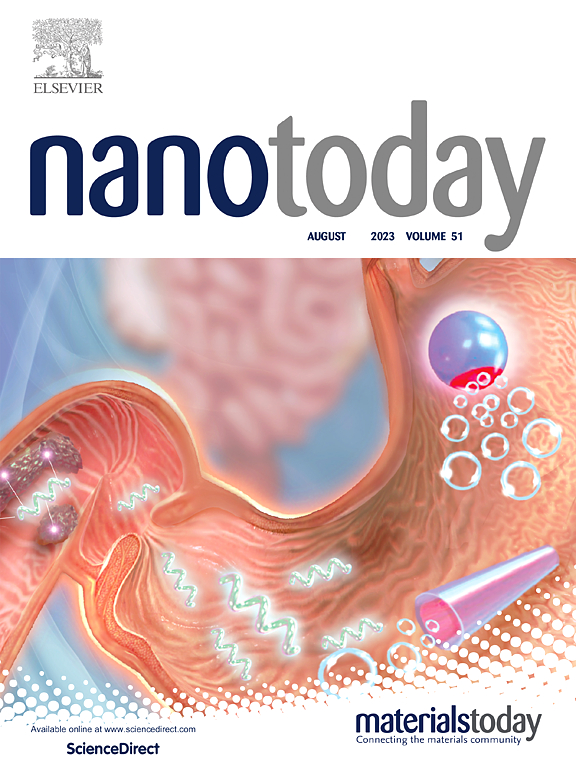四合一pH/葡萄糖反应工程水凝胶用于糖尿病伤口愈合
IF 13.2
1区 材料科学
Q1 CHEMISTRY, MULTIDISCIPLINARY
引用次数: 0
摘要
由于微生物定植、氧化还原稳态破坏、持续炎症反应和血管再生受损等因素的影响,糖尿病伤口的愈合一直是全球临床面临的重大挑战。目前,还没有临床有效的治疗策略。在这项研究中,我们开发了一种四合一多功能水凝胶PPy&;L-arg@PVA-TSPBA (PLPT),通过苯基硼酸基团与聚乙烯醇的羟基反应,具有自愈、粘合和微环境响应特性。该水凝胶含有抗氧化剂聚吡咯(PPy)和促进血管生成的化合物l -精氨酸(L-arg)。水凝胶中的硼酸酯键响应糖尿病感染伤口的高糖低pH微环境特征,从而触发治疗剂的可控释放。此外,聚吡啶赋予水凝胶优异的光热性能,并通过局部高温杀死细菌。PLPT水凝胶通过抑制IL-6/TNF-α促炎因子并上调VEGF和CD31,显示出明显的抗炎作用和增强新生血管的能力。细胞毒性和溶血试验表明,水凝胶具有良好的生物相容性。体内实验表明,PLPT通过清除细菌、缓解氧化应激、抑制炎症、促进血管生成等协同作用,促进糖尿病SD大鼠创面愈合,促进细胞外基质重建和胶原沉积。综上所述,PLPT水凝胶在糖尿病感染伤口的治疗中具有重要的临床应用潜力。本文章由计算机程序翻译,如有差异,请以英文原文为准。
Four-in-one pH/glucose-responsive engineered hydrogel for diabetes wound healing
The healing of diabetic wounds persists as a significant clinical challenge globally, attributed to factors involving microbial colonization, disrupted redox homeostasis, persistent inflammatory responses, and compromised vascular regeneration. Currently, therapeutic strategies that are clinically effective are not available. In this research, we developed a four-in-one multifunctional hydrogel, PPy&L-arg@PVA-TSPBA (PLPT), with self-healing, adhesive, and microenvironment-responsive properties by reacting phenylboronic acid groups with the hydroxyl groups of polyvinyl alcohol. The hydrogel was loaded with the antioxidant polypyrrole (PPy) and the angiogenesis-promoting compound L-arginine (L-arg). The borate ester bonds in the hydrogel respond to the high glucose and low pH microenvironment characteristic of infected diabetic wounds, thereby triggering the controlled release of therapeutic agents. Additionally, PPy imparts excellent photothermal properties to the hydrogel and kills bacteria through localized high temperatures. The PLPT hydrogel demonstrated pronounced anti-inflammatory efficacy and enhanced neovascularization capacity through suppression of IL-6/TNF-α pro-inflammatory factors coupled with up-regulation of VEGF and CD31. Cytotoxicity and hemolysis tests demonstrate that the hydrogel exhibits favorable biocompatibility. In vivo experiments show that PLPT accelerates wound healing in diabetic SD rats through a synergistic effect of bacterial eradication, oxidative stress mitigation, inflammation suppression, and angiogenesis promotion, which together facilitate extracellular matrix reconstruction and collagen deposition. In summary, the PLPT hydrogel have a significantly potential clinical application in the treatment of infected wounds in diabetes.
求助全文
通过发布文献求助,成功后即可免费获取论文全文。
去求助
来源期刊

Nano Today
工程技术-材料科学:综合
CiteScore
21.50
自引率
3.40%
发文量
305
审稿时长
40 days
期刊介绍:
Nano Today is a journal dedicated to publishing influential and innovative work in the field of nanoscience and technology. It covers a wide range of subject areas including biomaterials, materials chemistry, materials science, chemistry, bioengineering, biochemistry, genetics and molecular biology, engineering, and nanotechnology. The journal considers articles that inform readers about the latest research, breakthroughs, and topical issues in these fields. It provides comprehensive coverage through a mixture of peer-reviewed articles, research news, and information on key developments. Nano Today is abstracted and indexed in Science Citation Index, Ei Compendex, Embase, Scopus, and INSPEC.
 求助内容:
求助内容: 应助结果提醒方式:
应助结果提醒方式:


